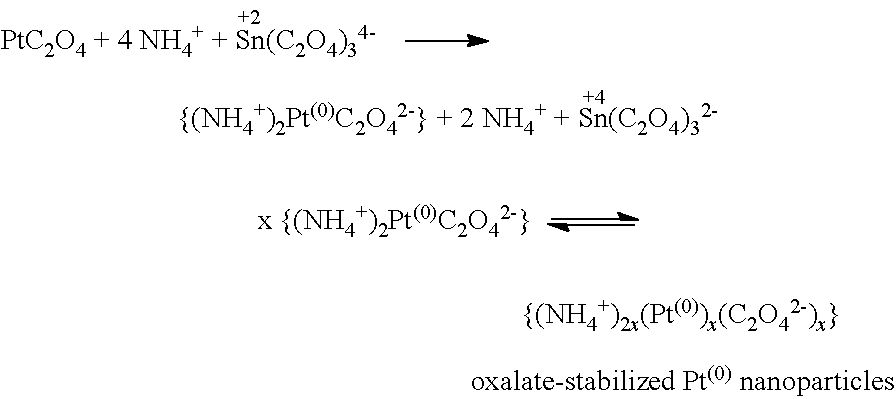Processes for making tin-containing catalysts
a technology of catalysts and manufacturing processes, applied in the direction of physical/chemical process catalysts, metal/metal-oxide/metal-hydroxide catalysts, organic compounds/hydrides/coordination complexes, etc., can solve the problem of low selectivity of the desired product based on the amount of converted acetic acid, and difficulty in achieving the desired hydrogenation product with conventional catalysts and supports, etc. problem, to achieve the effect of solubilizing the tin
- Summary
- Abstract
- Description
- Claims
- Application Information
AI Technical Summary
Benefits of technology
Problems solved by technology
Method used
Image
Examples
examples
Preparation of Hydrogenation Catalysts
[0074]The following materials were utilized in the Examples:
[0075](a) Platinum oxalate, PtC2O4, (solution, 13.638 wt % Pt) from Heraeus.
[0076](b) Tin(II) oxalate, SnC2O4 and ammonium oxalate monohydrate,
[0077](c) (NH4)2C2O4H2O purchased from Aldrich and used without further purification.
[0078]A modified silica support (HSA SS #61138, SA=250 m2 / g) from NorPro Saint Gobain, SiO2—CaSiO3(6), having 6 wt % CaSiO3 was dried at 120° C. under circulating air overnight prior to use.
[0079]A mixed metal precursor was prepared as follows. 1.62 g (11.38 mmol) of solid ammonium oxalate monohydrate was added to 50 ml of deionized H2O and dissolved with stirring at room temperature. 0.94 g (4.55 mmol) of tin(II) oxalate was added to the ammonium oxalate solution. The resultant mixture was stirred for another ten minutes at room temperature yielding a slightly opaque, colorless solution. 6.51 g of the platinum(II) oxalate solution (13.638 wt % Pt) was diluted to...
PUM
| Property | Measurement | Unit |
|---|---|---|
| Temperature | aaaaa | aaaaa |
| Temperature | aaaaa | aaaaa |
| Temperature | aaaaa | aaaaa |
Abstract
Description
Claims
Application Information
 Login to View More
Login to View More - R&D
- Intellectual Property
- Life Sciences
- Materials
- Tech Scout
- Unparalleled Data Quality
- Higher Quality Content
- 60% Fewer Hallucinations
Browse by: Latest US Patents, China's latest patents, Technical Efficacy Thesaurus, Application Domain, Technology Topic, Popular Technical Reports.
© 2025 PatSnap. All rights reserved.Legal|Privacy policy|Modern Slavery Act Transparency Statement|Sitemap|About US| Contact US: help@patsnap.com


